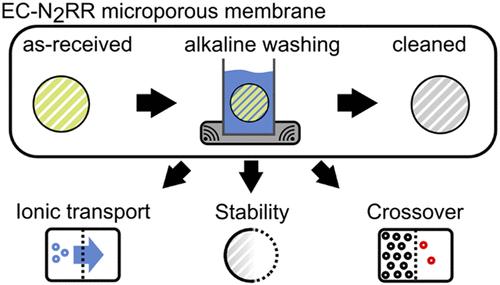水电化学氮还原反应膜分离器的制备及比较评价
IF 13.1
1区 化学
Q1 CHEMISTRY, PHYSICAL
引用次数: 0
摘要
电化学氮(N2)还原为氨(NH3)的催化剂筛选受到与实验装置和环境相关的各种污染源引起的虚假结果的影响。作为电化学电池的关键组成部分,隔膜是防止合成NH3氧化的必要条件,特别是在低产率的水溶液电化学氮还原反应(EC-N2RR)中。然而,仍然需要一种坚固且无污染的膜,包括系统地评估其对该反应的电化学适用性。在这里,我们报告了一种简单而有效的清洁方法,用于最近引入的微孔Celgard膜。研究表明,清洁后的Celgard膜在碱性电解质中表现优于其他常用的EC-N2RR膜,与Nafion质子交换膜相比,具有更好的离子传输能力,与Fumasep阴离子交换膜相比,具有更高的化学惰性和结构稳定性。除了指导膜的选择之外,本研究还提供了管理污染的综合策略,以及设计和操作几乎无污染的EC-N2RR工作站的框架,从而实现可靠的水性EC-N2RR催化剂筛选。本文章由计算机程序翻译,如有差异,请以英文原文为准。

Preparation and Comparative Evaluation of Membrane Separators for Aqueous Electrochemical Nitrogen Reduction Reaction Measurements
Catalyst screening for electrochemical nitrogen (N2) reduction to ammonia (NH3) suffers from spurious results caused by various sources of contamination associated with the experimental setup and the environment. As a crucial component of the electrochemical cell, a separator membrane is necessary to prevent the oxidation of as-synthesized NH3, specifically for low-yield aqueous electrochemical nitrogen reduction reactions (EC-N2RR). However, there remains a key need for a robust and contamination-free membrane, including systematic assessments of its electrochemical suitability for this reaction. Here, we report a simple yet effective cleaning process for the recently introduced microporous Celgard membrane. We show that the cleaned Celgard membrane outperforms other commonly used EC-N2RR membranes in alkaline electrolytes, exhibiting superior ion transport compared to a Nafion proton exchange membrane and enhanced chemical inertness and structural stability compared to a Fumasep anion exchange membrane. Beyond guiding membrane selection, this study provides a comprehensive strategy for managing contamination and a framework for designing and operating nearly contamination-free EC-N2RR workstations, enabling reliable catalyst screening for aqueous EC-N2RR.
求助全文
通过发布文献求助,成功后即可免费获取论文全文。
去求助
来源期刊

ACS Catalysis
CHEMISTRY, PHYSICAL-
CiteScore
20.80
自引率
6.20%
发文量
1253
审稿时长
1.5 months
期刊介绍:
ACS Catalysis is an esteemed journal that publishes original research in the fields of heterogeneous catalysis, molecular catalysis, and biocatalysis. It offers broad coverage across diverse areas such as life sciences, organometallics and synthesis, photochemistry and electrochemistry, drug discovery and synthesis, materials science, environmental protection, polymer discovery and synthesis, and energy and fuels.
The scope of the journal is to showcase innovative work in various aspects of catalysis. This includes new reactions and novel synthetic approaches utilizing known catalysts, the discovery or modification of new catalysts, elucidation of catalytic mechanisms through cutting-edge investigations, practical enhancements of existing processes, as well as conceptual advances in the field. Contributions to ACS Catalysis can encompass both experimental and theoretical research focused on catalytic molecules, macromolecules, and materials that exhibit catalytic turnover.
 求助内容:
求助内容: 应助结果提醒方式:
应助结果提醒方式:


